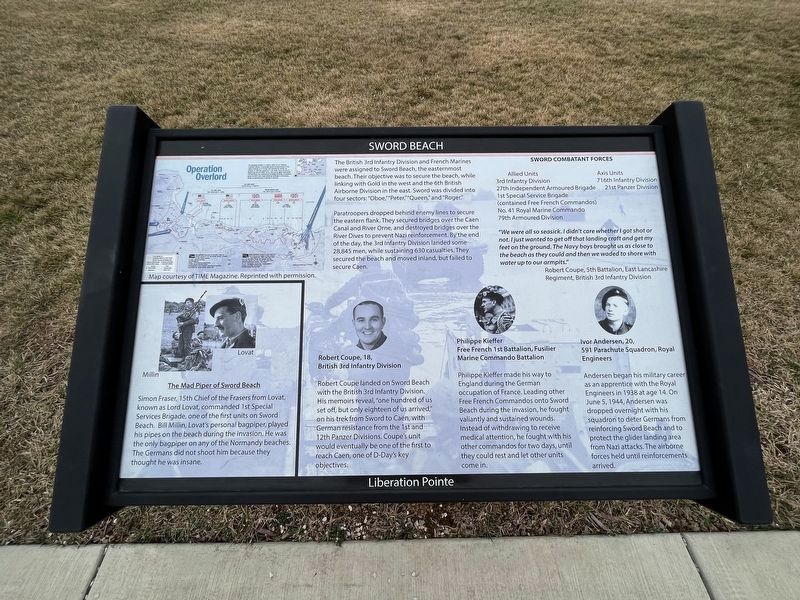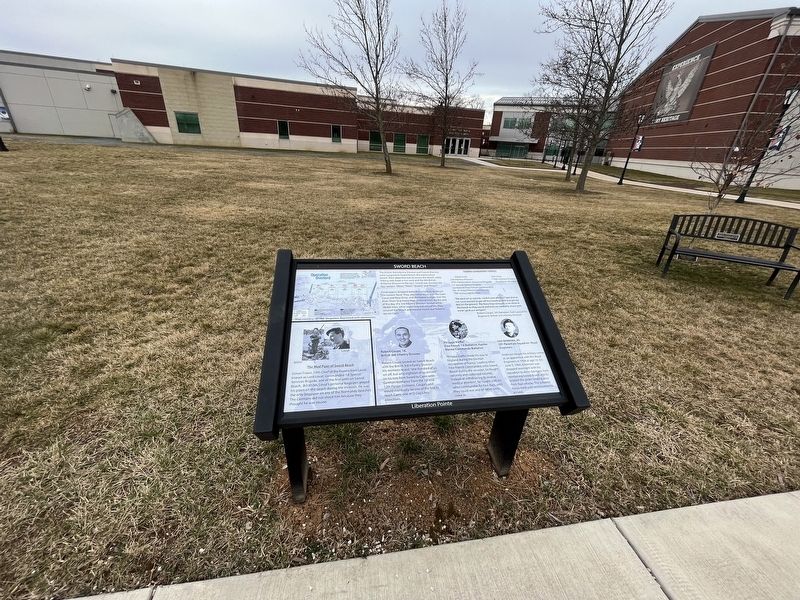Middlesex Township near Carlisle in Cumberland County, Pennsylvania — The American Northeast (Mid-Atlantic)
Sword Beach
Liberation Pointe
The British 3rd Infantry Division and French Marines were assigned to Sword Beach, the easternmost beach. Their objective was to secure the beach, while linking with Gold in the west and the 6th British Airborne Division in the east. Sword was divided into four sectors: "Oboe," "Peter," "Queen," and "Roger."
Paratroopers dropped behind enemy lines to secure the eastern flank. They secured bridges over the Caen Canal and River Orne, and destroyed bridges over the River Dives to prevent Nazi reinforcement. By the end of the day, the 3rd Infantry Division landed some 28,845 men, while sustaining 630 casualties. They secured the beach and moved inland, but failed to secure Caen.
Sword Combatant Forces
Allied Units 3rd Infantry Division • 27th Independent Armoured Brigade • 1st Special Service Brigade (contained Free French Commandos) • No. 41 Royal Marine Commando • 79th Armoured Division
Axis Units 716th Infantry Division • 21st Panzer Division
"We were all so seasick. I didn't care whether I got shot or not. I just wanted to get off that landing craft and get my feet on the ground. The Navy boys brought us as close to the beach as they could and then we waded to shore with water up to our armpits."
Robert Coupe, 5th Battalion, East Lancashire Regiment, British 3rd Infantry Division
Robert Coupe, 18,
British 3rd Infantry Division
Robert Coupe landed on Sword Beach with the British 3rd Infantry Division. His memoirs reveal, "one hundred of us set off, but only eighteen of us arrived," on his trek from Sword to Caen, with German resistance from the 1st and 12th Panzer Divisions. Coupe's unit would eventually be one of the first to reach Caen, one of D-Day's key objectives.
Philippe Kieffer
Free French 1st Battalion, Fusilier
Marine Commando Battalion
Philippe Kieffer made his way to England during the German occupation of France. Leading other Free French Commandos onto Sword Beach during the invasion, he fought valiantly and sustained wounds. Instead of withdrawing to receive medical attention, he fought with his other commandos for two days, until they could rest and let other units come in.
Ivor Andersen, 20,
591 Parachute Squadron, Royal Engineers
Andersen began his military career as an apprentice with the Royal Engineers in 1938 at age 14. On June 5, 1944, Andersen was dropped overnight with his squadron to deter Germans from reinforcing Sword Beach and to protect the glider landing area from Nazi attacks. The airborne forces held until reinforcements arrived.
[Caption:]
The greatest invasion in history relied on an intricate multipart attack. A prolonged aerial bombardment in the weeks leading up to D-day was followed by further air attacks on German positions in the early hours of June 6. Beginning around 0500 hours, Navy guns again hammered the Germans; the amphibious landings followed. In addition, some 24,000 men made airborne landings in Normandy, either by parachuting or landing in gliders.
Topics. This historical marker is listed in these topic lists: Air & Space • Arts, Letters, Music • War, World II • Waterways & Vessels. A significant historical date for this entry is June 5, 1944.
Location. 40° 12.438′ N, 77° 9.606′ W. Marker is near Carlisle, Pennsylvania, in Cumberland County. It is in Middlesex Township. Marker is on Soldiers Drive south of Army Heritage Drive, on the right when traveling east. Touch for map. Marker is at or near this postal address: 950 Soldiers Dr, Carlisle PA 17013, United States of America. Touch for directions.
Other nearby markers. At least 8 other markers are within walking distance of this marker. Juno Beach (here, next to this marker); Utah Beach (here, next to this marker); Gold Beach (here, next to this marker); Ranger and Airborne Operations (here, next to this marker); Omaha Beach (here, next to this marker); Operation Overlord (here, next to this marker); Corporal John D. LaWall (a few steps from this marker); Private First Class Willard Dominick (a few steps from this marker). Touch for a list and map of all markers in Carlisle.
Credits. This page was last revised on February 28, 2023. It was originally submitted on February 28, 2023, by Devry Becker Jones of Washington, District of Columbia. This page has been viewed 87 times since then and 16 times this year. Photos: 1, 2. submitted on February 28, 2023, by Devry Becker Jones of Washington, District of Columbia.

